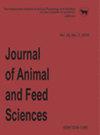炎症对促炎症细胞因子及其受体在母羊体液轴不同水平上的基因表达的时间依赖性影响
IF 1.5
4区 农林科学
Q3 AGRICULTURE, DAIRY & ANIMAL SCIENCE
引用次数: 0
摘要
.垂体-下丘脑-泌乳素轴(HPS)在哺乳动物的新陈代谢和生理过程中起着关键的调节作用。人们认为,促炎细胞因子等炎症介质(其受体广泛存在于 HPS 轴的不同层次)可能是干扰该轴活动的原因。我们的研究旨在确定脂多糖(LPS)诱导的炎症对 HPS 轴所属器官中编码促炎细胞因子及其受体的基因表达的影响。对母羊(36 头)进行了体内研究,随机分为 3 个时间依赖组(每组 12 头)。每个时间组又分为两个亚组:对照组(生理盐水处理;n = 6)和静脉注射 LPS(400 ng/kg;n = 6)处理组。动物在注射 LPS 1.5 小时、3 小时或 9 小时后安乐死,收集背内侧下丘脑和基底中层下丘脑、垂体前叶和肝脏的碎片。用实时荧光定量PCR技术测定了IL1B、IL1R1、IL1R2、IL6、IL6R、IL6ST、TNF、TNFRSF1A和TNFRSF1B的相对基因表达。我们的实验表明,LPS 诱导的炎症会调节绵羊 HPS 轴不同水平上的促炎细胞因子(如 IL1B、IL6 和 TNF)及其相应受体的基因表达,且其表达具有时间依赖性。由于这些细胞因子是众所周知的激素和神经激素分泌的强效调节剂,这些局部合成的细胞因子的旁分泌作用可能会干扰 HPS 轴的活性,但这还需要进一步的深入研究。本文章由计算机程序翻译,如有差异,请以英文原文为准。
Time-dependent effect of inflammation on the gene expression of pro-inflammatory cytokines and their receptors at the different levels of the somatotropic axis in ewe
. Pituitary-hypothalamic-somatotropic (HPS) axis plays a key regulatory role in the metabolic and physiological processes in mammals. It is considered that inflammatory mediators such as proinflammatory cytokines, whose receptors are widespread at the different levels of the HPS axis, may be responsible for disturbing this axis activity. Our study was carried out to determine the effect of lipopolysaccharide (LPS)-induced inflammation on the expression of genes encoding pro-inflammatory cytokines and their receptors in the organs belonging to the HPS axis. In vivo studies were carried out on ewes (n = 36) divided randomly into 3 time-dependent groups (n = 12; each). Each time group was divided into two subgroups: control (saline-treated; n = 6) and intravenously treated with LPS (400 ng/kg; n = 6). Animals were euthanized 1.5 h, 3 h, or 9 h after LPS injection; and the fragments of the dorsomedial hypothalamus and mediobasal hypothalamus, anterior pituitary, and liver were collected. The relative gene expression encoding IL1B, IL1R1, IL1R2, IL6, IL6R, IL6ST, TNF, TNFRSF1A, and TNFRSF1B was determined with real-time PCR. Our experiment showed that LPS-induced inflammation modulates the gene expression of pro-inflammatory cytokines such as IL1B , IL6 , and TNF and their corresponding receptor at the different levels of the HPS axis in sheep at the time-dependent manner. Because these cytokines are known as potent modulators of the secretion of hormones and neurohormones, the paracrine action of these locally synthesized cytokines may disturb the activity of the HPS axis; however, it requires further deep-in research.
求助全文
通过发布文献求助,成功后即可免费获取论文全文。
去求助
来源期刊

Journal of Animal and Feed Sciences
农林科学-奶制品与动物科学
CiteScore
2.10
自引率
0.00%
发文量
42
审稿时长
3 months
期刊介绍:
Journal of Animal and Feed Sciences (JAFS, J. Anim. Feed Sci.) has been published by the Kielanowski Institute of Animal Physiology and Nutrition, Polish Academy of Sciences in Jabłonna (Poland) since 1991. It is a continuation of the Polish-language journal Roczniki Nauk Rolniczych. Seria B, Zootechniczna published by the Polish Academy of Sciences since 1969.
JAFS is an international scientific journal published quarterly, about 40 papers per year including original papers, short communications and occasionally reviews. All papers are peer-reviewed and related to basic and applied researches in the field of animal breeding and genetics, physiology of nutrition, animal feeding, feed technology and food preservation. The journal distinguishes the multidisciplinary nature of physiological and nutritional sciences and so includes papers specialized in all fields connected with animal well-being, including molecular and cell biology and the emerging area of genetics.
 求助内容:
求助内容: 应助结果提醒方式:
应助结果提醒方式:


